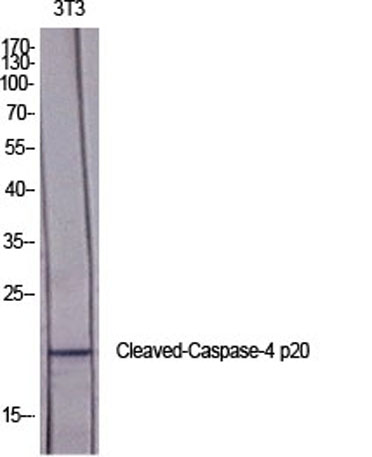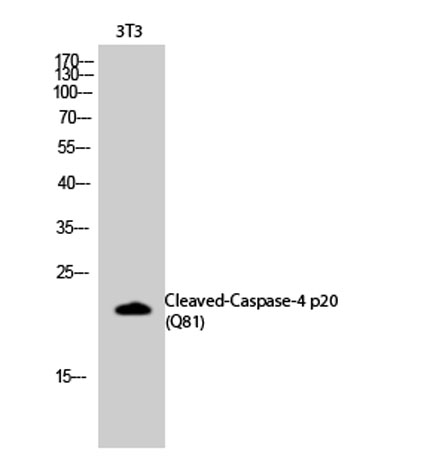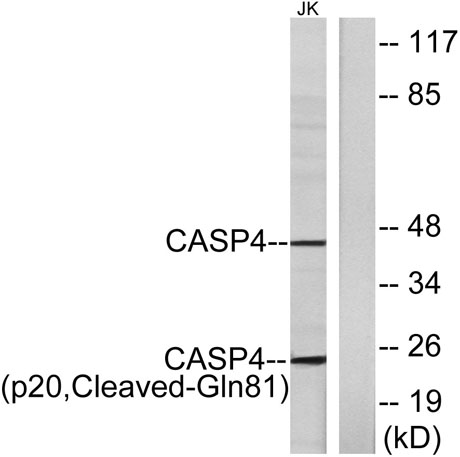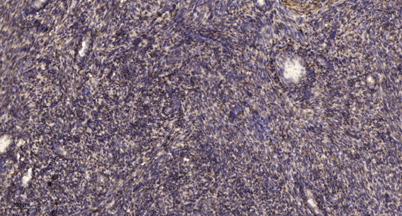









Cleaved-Caspase-4 p20 (Q81) rabbit pAb
 One-click to copy product information
One-click to copy product information$148.00/50µL $248.00/100µL
| 50 µL | $148.00 |
| 100 µL | $248.00 |
Overview
| Product name: | Cleaved-Caspase-4 p20 (Q81) rabbit pAb |
| Reactivity: | Human |
| Alternative Names: | CASP4; ICH2; Caspase-4; CASP-4; ICE(rel)-II; Protease ICH-2; Protease TX |
| Source: | Rabbit |
| Dilutions: | Western Blot: 1/500 - 1/2000. Immunohistochemistry: 1/100 - 1/300. ELISA: 1/40000. Not yet tested in other applications. |
| Immunogen: | The antiserum was produced against synthesized peptide derived from human Caspase 4. AA range:62-111 |
| Storage: | -20°C/1 year |
| Clonality: | Polyclonal |
| Isotype: | IgG |
| Concentration: | 1 mg/ml |
| Observed Band: | 43+22kD |
| GeneID: | 837 |
| Human Swiss-Prot No: | P49662 |
| Cellular localization: | Cytoplasm, cytosol . Endoplasmic reticulum membrane ; Peripheral membrane protein ; Cytoplasmic side . Mitochondrion . Inflammasome . Secreted . Predominantly localizes to the endoplasmic reticulum (ER). Association with the ER membrane requires TMEM214 (PubMed:15123740). Released in the extracellular milieu by keratinocytes following UVB irradiation (PubMed:22246630). . |
| Background: | This gene encodes a protein that is a member of the cysteine-aspartic acid protease (caspase) family. Sequential activation of caspases plays a central role in the execution-phase of cell apoptosis. Caspases exist as inactive proenzymes composed of a prodomain and a large and small protease subunit. Activation of caspases requires proteolytic processing at conserved internal aspartic residues to generate a heterodimeric enzyme consisting of the large and small subunits. This caspase is able to cleave and activate its own precursor protein, as well as caspase 1 precursor. When overexpressed, this gene induces cell apoptosis. Alternative splicing results in transcript variants encoding distinct isoforms. [provided by RefSeq, Jul 2008], |
-
 Western Blot analysis of various cells using Cleaved-Caspase-4 p20 (Q81) Polyclonal Antibody diluted at 1:2000
Western Blot analysis of various cells using Cleaved-Caspase-4 p20 (Q81) Polyclonal Antibody diluted at 1:2000 -
 Western Blot analysis of 3T3 cells using Cleaved-Caspase-4 p20 (Q81) Polyclonal Antibody diluted at 1:2000
Western Blot analysis of 3T3 cells using Cleaved-Caspase-4 p20 (Q81) Polyclonal Antibody diluted at 1:2000 -
 Western blot analysis of lysates from Jurkat cells, using Caspase 4 (p20,Cleaved-Gln81) Antibody. The lane on the right is blocked with the synthesized peptide.
Western blot analysis of lysates from Jurkat cells, using Caspase 4 (p20,Cleaved-Gln81) Antibody. The lane on the right is blocked with the synthesized peptide. -
 Immunohistochemical analysis of paraffin-embedded human uterus. 1, Antibody was diluted at 1:200(4° overnight). 2, Tris-EDTA,pH9.0 was used for antigen retrieval. 3,Secondary antibody was diluted at 1:200(room temperature, 45min).
Immunohistochemical analysis of paraffin-embedded human uterus. 1, Antibody was diluted at 1:200(4° overnight). 2, Tris-EDTA,pH9.0 was used for antigen retrieval. 3,Secondary antibody was diluted at 1:200(room temperature, 45min).

 Manual
Manual